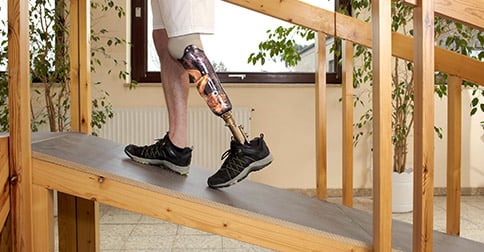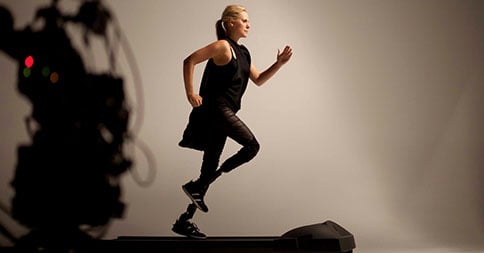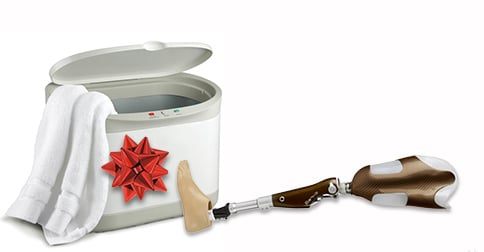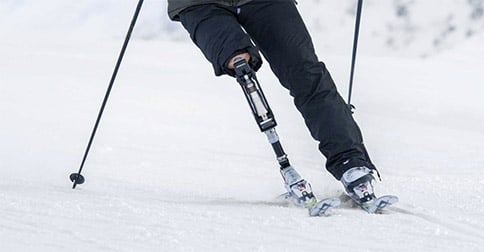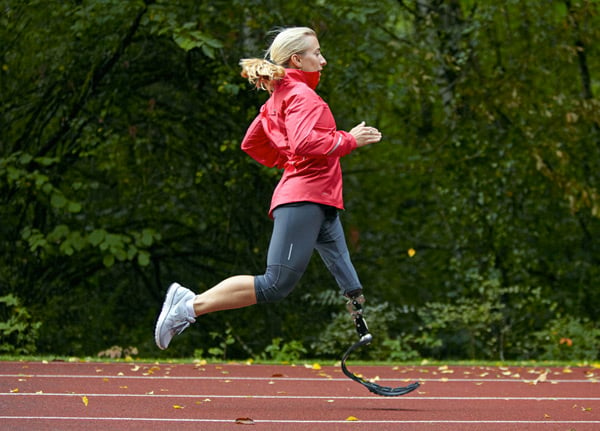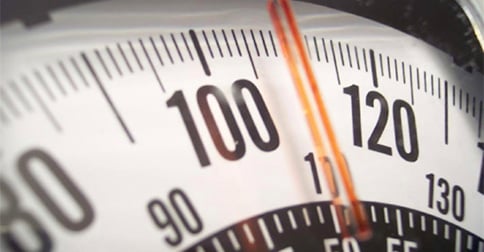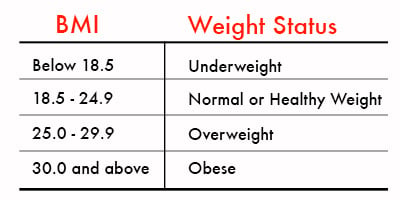If you are new to limb loss, the transition can be hard--but you can recognize your possibilities with BioTech! Maximize your experience with orthotic and prosthetic devices by following these simple tips.
#1: Clean and Care Properly
Cleaning your prosthesis can be tedious, but it is a vital part of caring for your device. First, use a towel to apply baby powder to the inside of the device, reducing moisture after wear. As for your residual limb, check every day for irritation and bruises. To help protect your limb after limb loss and reduce swelling while you sleep, you can wear a comfort socket.
#2: Wear Your Prosthesis Daily
If you are new to prosthetic technology, wearing your device daily may seem uncomfortable and awkward at first. However, the more you wear your prosthesis, the more you will get used to it. Soon, you’ll see an improvement in your functionality, and your device won’t feel quite so foreign.
#3: Eat and Exercise
Managing your diet is important, especially when it comes to regaining strength in your muscles. Stronger muscles help you regulate your gait, so give them the nutrients they need!
In addition to eating well, you need to exercise regularly. Your professional physical therapist can suggest a tailored exercise routine that fits your life and your needs. A sedentary lifestyle is not recommended, as it can result in an increased BMI and discomfort due to your residual limb fitting poorly into your prosthesis.
#4: Forward Focus
Getting used to wearing a new prosthetic device can be physically and emotionally overwhelming. Keep your head up! With a little patience, plus the help of caring professionals, you will be on the right path in no time.
BioTech Limb and Brace Will Get You There!
Recognize your possibilities with BioTech Limb and Brace in Birmingham, Alabama. Our passionate staff delivers excellent service and quality treatment solutions. Learn more about BioTech. Contact our team today!
We often look to celebrities to inspire us, to act as role models - and to serve as examples of what we can be when we recognize our possibilities, no matter what our circumstances may be.
For those who have experienced limb loss, Aimee Mullins is one such example. Aimee is a well-known model and actor who has built her career on advocating a new perspective on prosthetic devices for women, men, and children alike.
Learn about her journey, her success, and her innovative vision as a limb loss survivor and role model.
Aimee Mullins: Amputee
Aimee was born without her fibular bones and had both of her legs amputated below the knee. She began to walk on her first pair of prosthetic legs at the age of two.
Even from an early age, Aimee didn’t let limb loss define her or limit her. Like athlete Blake Leeper, Aimee found an affinity for sports at a young age and began wearing running prosthetic legs. She tried softball and soccer, swimming and skiing, excelling in a variety of activities. At seventeen, she graduated high school as the youngest person allowed top-security clearance at the Pentagon, with a full scholarship from the Department of Defense.
Sports Star and Model
During her time at Georgetown University, she became the first-ever amputee - male or female - to compete as an athlete in the NCAA. She began setting records nationally and internationally as a champion Paralympic sprinter and double amputee as she grew. At the same time, she began her modeling career, which then flourished into an acting career. During this time, she accepted the role of official Ambassador for the ESPN Tribeca Sports Film Festival and starred in Matthew Barney’s Cremaster 3, an avant-garde film.
Advocate and Ambassador
Aimee had an extraordinary vision. Instead of developing prostheses with human-like features, she looked into the abilities of animals. She was then outfitted with the first running prosthetic device modeled after a cheetah’s legs. Those legs now act as prototypes for many sports prosthetic devices. Her unique designs and creative vision are unparalleled.
Named one of People magazine’s “50 Most Beautiful People in the World,” Aimee represents L’Oreal Paris as their Global Brand Ambassador and continues to hold notable positions in organizations like Women’s Sports Foundation.
Additionally, Aimee has become an accomplished speaker. Her TED Talks are some of the most viewed in the history of the conference, and have been translated into 41 languages so they can share her inspiration around the globe.
Achieving Success like Aimee
Many of Aimee’s remarkable achievements come not only from her determination and spirit, but also from the prosthetic devices she has worn, which have expanded her horizons and given her the same capabilities as anyone else.
BioTech Limb and Brace in Birmingham, AL specializes in designing and developing prosthetic and orthopedic devices that allow people to go above and beyond whatever limitations they think they have due to limb loss. We like to show people that you are never limited - just like Aimee.
Contact our experienced team of professionals to start recognizing your possibilities today!
As the holiday season approaches, it is time for gift giving! If you have a friend or a family member that has experienced limb loss, then there are many practical gifts you can include in their stockings!
Check these ideas for this Christmas presents for amputees from BioTech Limb and Brace in Birmingham - Alabama’s designation for proper fitting prosthetic and orthotic devices.
#1: Baby Wipes and Baby Powder
Whether you are sending a care package or simply stuffing a stocking, a little box of baby wipes goes a long way to help keep prosthetic and orthotic devices clean. A bottle of a baby powder can also help since baby powder is good for keeping moisture to a minimum, making it more comfortable to wear a prosthetic or orthotic device during long periods of activity.
#2: Lotion and Lubricant
Sweat is well combated by baby powder; however, sometimes it is easy for the residual limb to feel dry during the colder months. Lotion can help keep skin moisturized, which can improve comfort.
When skin can get cold and dry, it can sometimes be harder to fit into a prosthesis in the winter. For this reason, a bottle of lubricant is a smart purchase that can be very practical for friends and family members with limb loss.
#3: Towel Warmer
If you feel like getting fancy, consider giving your friend or family member a towel warmer. This luxurious product will help them keep their liners and comfort socks warm before putting them on in the cold winter mornings.
#4: Socks, Socks, Socks!
Don’t we all love socks in our stockings? Consider gifting a nice, warm pair of fuzzy or fleece socks. Lower extremity residual limbs can get cold, especially during chilly winter nights. Many retail stores even carry socks that are lined with a soothing gel that are perfect for long days.
BioTech Gives the Gift of Possibility
Learn more about who we are and how we help patients recognize their possibilities everyday. Through personalized care and modern technology, we strive to give each patient an excellent experience. Contact BioTech Limb and Brace today to learn more.
Winter can be a slippery, sliding time for many of us. For those of us wearing prosthetic legs or orthopedic braces, the extreme weather can pose a threat. So, how do you stay safe and warm and not feel itchy or uncomfortable? Follow these tips from BioTech Limb and Brace!
#1: Get Gear with a Grip
When we’re talking about staying safe in the winter - when weather gets nasty - it all comes down to grip.
Resist sliding on ice or in snow by making sure that all of your shoes have good grip. No matter the weather, good traction will keep you safe and keep your feet on solid ground. Flats or sneakers with rubber soles will keep you stable - just don’t try heels outdoors! If you are going to experience severe weather, consider investing in snow shoes, weatherproof boots, or ice cleats.
To ensure comfort even under layers of wool and fleece, learn more about custom BioTech comfort sockets. Gel liners for your prosthetic leg will also keep you both warm and comfortable, even in harsh weather. Your flexibility and range of motion will improve, and overall you will simply be more comfortable.
#2: Stay Warm
Beyond footwear, your prosthetic leg or hand must be worn at all times in the cold. If your orthopedic professional suggests that you wear a knee or leg brace, make sure that you do not skip a day during the winter. Especially during this season, if your residual limb is left uncovered, you may experience pain and irritation. Cold weather can leave your extremities in a lot of pain, due to barometric pressure, if you are not careful.
If you have experienced limb loss due to natural causes or surgery, maintaining body warmth, no matter your Body Mass Index, is important. Warm layers and adequate material like waterproof jackets and appropriate footwear will keep you comfortable in the cold.
#3: Talk to Your Therapist
At BioTech Limb and Brace in Birmingham, AL we are committed to excellent service and patient satisfaction. We are thrilled to have the opportunity to form new relationships with patients, because we consider everyone who comes to visit family. During this holiday season, we are reminded of how grateful we are for our patients and for modern technology that helps us recognize possibilities for those patients everyday.
Learn more for yourself by checking out our latest blog or contacting a personal professional on the BioTech team today.
Prosthetic devices can be life-changing, especially for those with limb loss who lead very active lives. Believe it or not, these prosthetic legs go beyond practicality; they provide more than comfort and function. Keep reading to learn more!
With a dedicated team behind you and a custom-fitted prosthesis, BioTech Limb and Brace helps our patients recognize their possibilities and continue to live active lives!
Inspiring Patients
We absolutely love working with our patients and seeing them accomplish incredible things with the new devices. We are continually inspired by their perseverance and tenacity.
For example, Danielle has been with us for thirteen years. As a teenager, Danielle’s running prosthesis allowed her to participate in high school athletics and equestrian sport. Take a minute to learn more about Danielle’s inspiring story here.
Quin, a student-athlete, has been part of the BioTech family for approximately one year. Quin’s story is truly incredible! A thirteen-year-old in love with baseball came to BioTech to get a custom engineered running prosthetic leg. Within months, he achieved more than we could have ever imagined. He was running in the parking lot the day he tried it on. Take a minute to learn more about Quin’s journey.
A Prosthetic Advantage
Running prosthetic legs enable our patients to run using significantly less energy than able-bodied athletes. The difference is actually greater than you might think.
During a run, there is a loss of energy that comes with the push-off of the foot from the ground. With a prosthetic leg, that loss of energy is substantially less, which adds more power to each stride.
As you run, your body sends energy into the ground, receives some of that energy back, and then pushes forward from that energy. The stiffer the leg, the more energy is returned. For this reason, a running prosthetic can actually give you an edge on the competition!
Professional runners run with less vertical force and movement, which means they don’t bounce up and down as much as amateurs. Therefore, they conserve more energy, thereby increasing stamina and reduce fatigue.
Get Into Your Running Prosthetic Leg Today
At BioTech Limb and Brace, we consider all of our patients family. We would love to help you recognize your possibilities and live healthier, more active lives!
Learn more about our advanced technology and custom fitted prosthetic or orthotic devices. Contact us today.
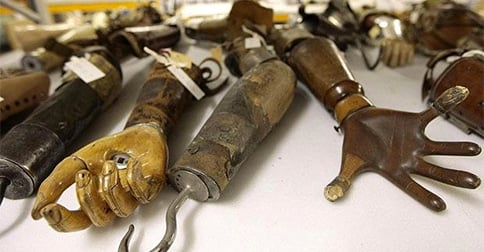 Technology today offers millions of patients a new chance at a healthy life. Prosthetic devices and orthotic devices have changed the face of medicine.
Technology today offers millions of patients a new chance at a healthy life. Prosthetic devices and orthotic devices have changed the face of medicine.
So, how did it all start? When did these devices begin to change lives, and what were they first made of? Learn more about the history of prosthetic devices with BioTech Limb and Brace in Birmingham, Alabama.
The First Prosthetic Device
It is claimed that the very first artificial limb prosthetic device was actually not what you might expect. It was a toe! Legend has it that thousands of years ago, a wealthy woman in Egypt lost her toe and could no longer wear traditional Egyptian sandals. To help her maintain her identity and function, the first prosthetic device, a wooden toe, was created. From there, technology (thankfully) has only progressed.
Military Accounts of Prosthetic Devices
Most accounts of prosthetic technology advancement following Egypt come from military stories. Many soldiers have lost their arms or legs during war resulting in a need for artificial limb prosthetic devices. Starting in the early sixteenth century, early prosthetic devices were built from wood and then iron. Soon designers began mixing materials and other metals to create more durable and yet flexible options.
Added Flexibility with One Important Innovation
Ambroise Paré, a French barber surgeon, was responsible for many advances in amputation surgery and prosthetic technology. He was the first person to develop hinged prosthetic devices. These allowed patients to move more freely and naturally, even while wearing their prosthetic limb. Not only were patients now able to feel support and comfort; they were also given increased functionality.
Today’s Technology: Advancing Prosthetic Use
Advancements in artificial limb prosthetic devices have dramatically changed lives over the years. Today technology has come so far. It’s exciting what we can do! From transfemoral designed comfort sockets to custom prosthetic devices and orthotic devices, modern technology allows patients to have strong, light, flexible devices that enhance their lives. These devices give patients a sense of wholeness, functionality and flexibility, and comfort and support.
The BioTech Difference
At BioTech Limb and Brace, we work hard to make every patient feel like family. We want to help you recognize your possibilities with custom prosthetic and orthotic devices.
Contact us today to learn more and experience the BioTech difference.
Knowing your body mass index - BMI - can be helpful when determining your health and fitness level. But calculating BMI for a person who has suffered from limb loss can be challenging. How do you determine your BMI while missing a limb?
Here is a simple guide to BMI and calculating this figure with a missing limb or limbs.
What Is BMI?
As you probably already know, BMI is a measurement of your weight divided by your height. Typically, this is measured in kilograms over meters.
Contrary to popular belief, your BMI number does not indicate your body fat. Rather it can help determine what weight category you fall into which correlates with your level of health. Categories include underweight, normal, healthy, overweight, and obese.
As dictated by the Center of Disease Control, a Body Mass Index below 18.5 is considered underweight. A BMI over 25.0 is overweight, and above 30.0 is obese. Ideally, healthy weight status occurs when your BMI is between 18.5 and 25.0.
How is My BMI Affected by Limb Loss?
Those with limb loss often find it difficult to determine your BMI. Amputations result in patients inherently losing some weight, on average around 1 to 5 kilograms depending on the limb.
As someone with limb loss, you can calculate your body weight by dividing your body weight by the percentage of the amputated limb subtracted from a total of 100. Therefore, your body weight would be given by this simple formula:
 For example, if you were to lose 5% of your body weight as a result of amputation, your body weight as calculated by this formula would be your present weight divided by 95, then multiplied by 100. Don’t worry about including the weight of your prosthetic or orthotic device.
For example, if you were to lose 5% of your body weight as a result of amputation, your body weight as calculated by this formula would be your present weight divided by 95, then multiplied by 100. Don’t worry about including the weight of your prosthetic or orthotic device.
Finally, to calculate your BMI, you would take that number and divide it by your height.
Let BioTech Limb and Brace Help
Losing a limb can make calculating your BMI a bit confusing. If you are having difficulty figuring it all out, our expert team is here to help!
Your quality of life and health are very important to us. Contact BioTech Limb and Brace today. Let us help you recognize your possibilities!
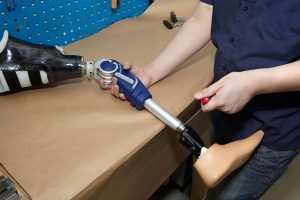 Your prosthesis is a unique tool that provides you with comfort and functionality. However, like any tool, your custom prosthesis can simply lose its effectiveness with time, especially due to a changing fit. Therefore, replacing your prosthesis is vital.
Your prosthesis is a unique tool that provides you with comfort and functionality. However, like any tool, your custom prosthesis can simply lose its effectiveness with time, especially due to a changing fit. Therefore, replacing your prosthesis is vital.
Replace Sooner than Later
Most professionals recommend replacing your device every three to five years. Depending on your lifestyle, how much daily wear and tear your device experiences, and your personal preferences, your replacement may need to be made sooner.
Many invest in a new custom prosthesis sooner than later to avoid inconvenient maintenance visits and fees. Repairs add up over time. When parts are worn, your prosthesis does not function as it should. It can also be uncomfortable and require you to exert more energy.
To improve the efficiency of your device, your first socket should be replaced within the first three to six months. The socket will most likely have to be replaced two or three times within in the year. Frequent changes are best.
Recognizing Residual Limb Change
The longer you have your prostheses, the better you will get at recognizing residual limb changes. Your prosthetist will always have the best recommendations. Every three months, it is best to check in with your professional for preventative care.
For utmost comfort, wearing more than one sock can help. However, having to wear thicker ply socks is a sign of limb shrinkage. This can affect how well your socket fits your residual limb. Our BioTech comfort sockets help provide the most comfort and functionality.
Any red or sore area should be tended to immediately. That is usually a sign of the residual limb changing shape.
Let the Experts at BioTech Help Today!
Learn about proper prosthetic socket care at BioTech Limb and Brace. Let our team help you improve your functionality and comfort with a custom prosthesis today!
We specialize in custom prosthetic and orthotic devices. Contact BioTech Limb and Brace to make an appointment or give us a call today to learn how we can help you recognize your possibilities.
